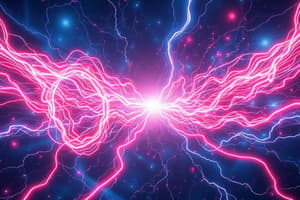Podcast
Questions and Answers
What is the relationship between the magnetic field dB and the distance r according to the Biot-Savart law?
What is the relationship between the magnetic field dB and the distance r according to the Biot-Savart law?
- dB is not affected by r
- dB is directly proportional to r
- dB is inversely proportional to the square of r (correct)
- dB is inversely proportional to r
According to the Biot-Savart law, what factor does not influence the magnitude of the magnetic field dB?
According to the Biot-Savart law, what factor does not influence the magnitude of the magnetic field dB?
- Element length |dl|
- Distance squared r^2
- Current I
- Electric charge Q (correct)
Which statement correctly describes the direction of the magnetic field dB according to the Biot-Savart law?
Which statement correctly describes the direction of the magnetic field dB according to the Biot-Savart law?
- dB is parallel to the length element dl
- dB points towards the source of current
- dB is perpendicular to the plane containing dl and r (correct)
- dB is along the direction of current I
What is the constant of proportionality in SI units in the Biot-Savart law?
What is the constant of proportionality in SI units in the Biot-Savart law?
What aspect differentiates the electric field from the magnetic field according to the provided content?
What aspect differentiates the electric field from the magnetic field according to the provided content?
What is the primary effect of distance on both electric and magnetic fields?
What is the primary effect of distance on both electric and magnetic fields?
What happens to the magnetic field if the current I flowing through the conductor is increased?
What happens to the magnetic field if the current I flowing through the conductor is increased?
In the Biot-Savart law equation, which element signifies the angle between the current element and the displacement vector?
In the Biot-Savart law equation, which element signifies the angle between the current element and the displacement vector?
Flashcards are hidden until you start studying
Study Notes
Magnetic Field and Current
- All magnetic fields originate from currents (moving charges) or intrinsic magnetic moments of particles.
- The relationship between current and the magnetic field it generates is defined by the Biot-Savart law.
Biot-Savart Law
- Considers a finite conductor carrying current I, with an infinitesimal element dl.
- Calculates the magnetic field dB at a point P, located at distance r from the current element.
- The angle θ represents the angle between dl and the displacement vector r.
Magnetic Field Calculation
- The magnitude of dB is proportional to:
- Current I
- Length of the current element |dl|
- Inversely proportional to the square of the distance r
- The direction of dB is perpendicular to the plane formed by dl and r.
Mathematical Representation
- The vector relationship is given by:
- dB ∝ (I × dl) / r²
- dB = (μ0/4π) * (I * dl × r) / r²
- The constant μ0/4π is specific to a vacuum.
- The formula for the magnitude of the magnetic field:
- dB = (μ0/4π) * (I * |dl| * sinθ) / r²
Key Constants
- The proportionality constant in SI units:
- μ0 = 4π × 10^-7 Tm/A, known as the permeability of free space or vacuum.
Comparisons with Electrostatic Field
- Similarities with Coulomb’s law for electrostatic fields:
- Both are long-range forces, inversely dependent on the square of the distance from the source.
- The superposition principle applies to both fields.
- Differences:
- Electrostatic fields are generated by scalar sources (electric charges).
- Magnetic fields arise from vector sources (current elements I dl).
Studying That Suits You
Use AI to generate personalized quizzes and flashcards to suit your learning preferences.




